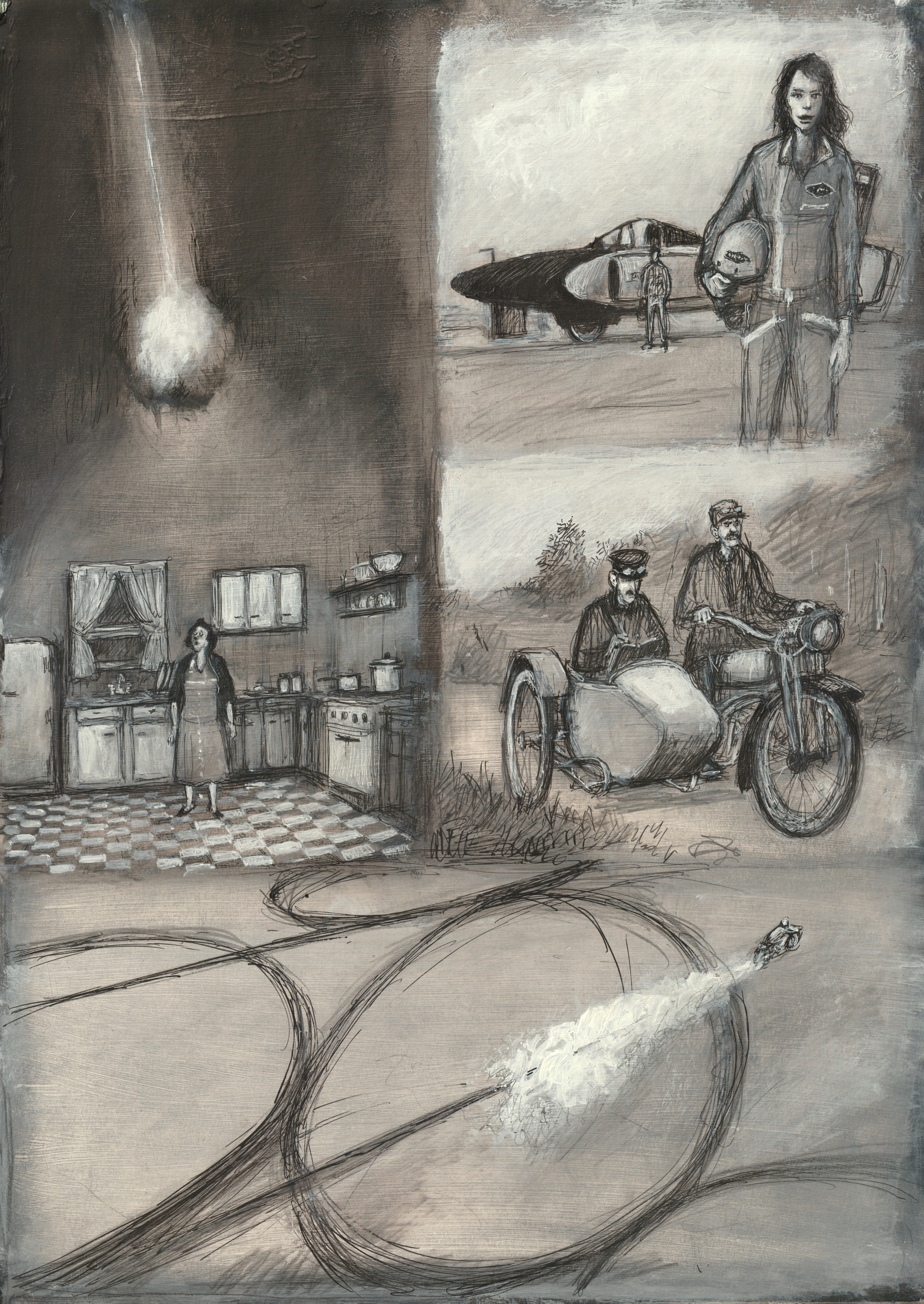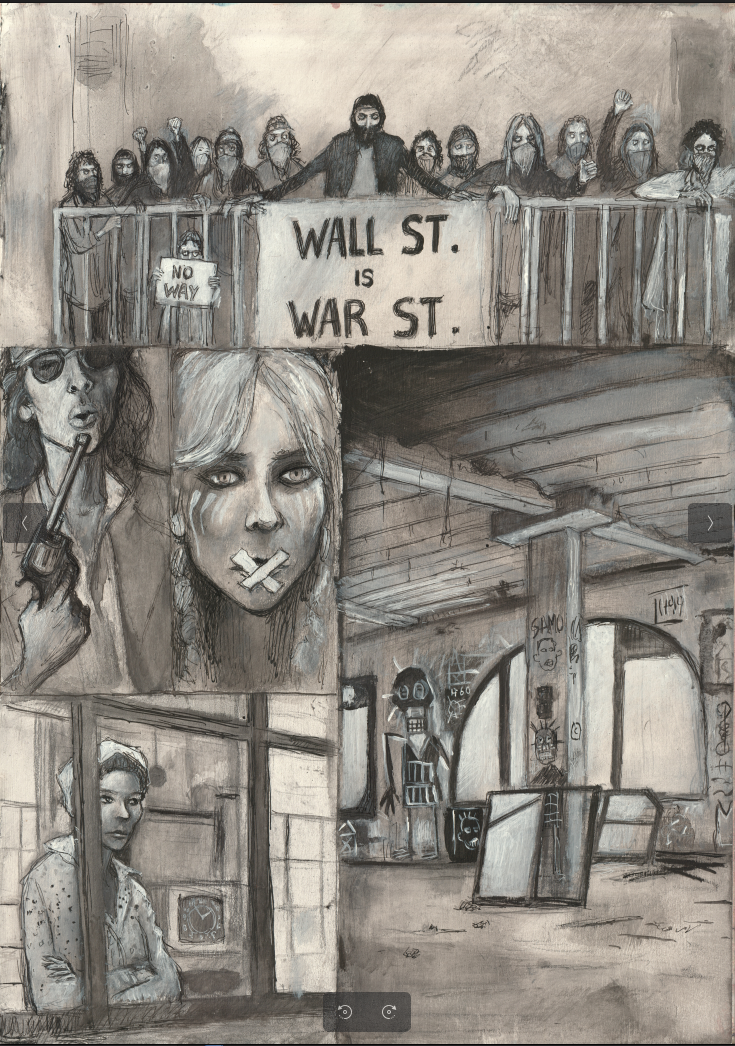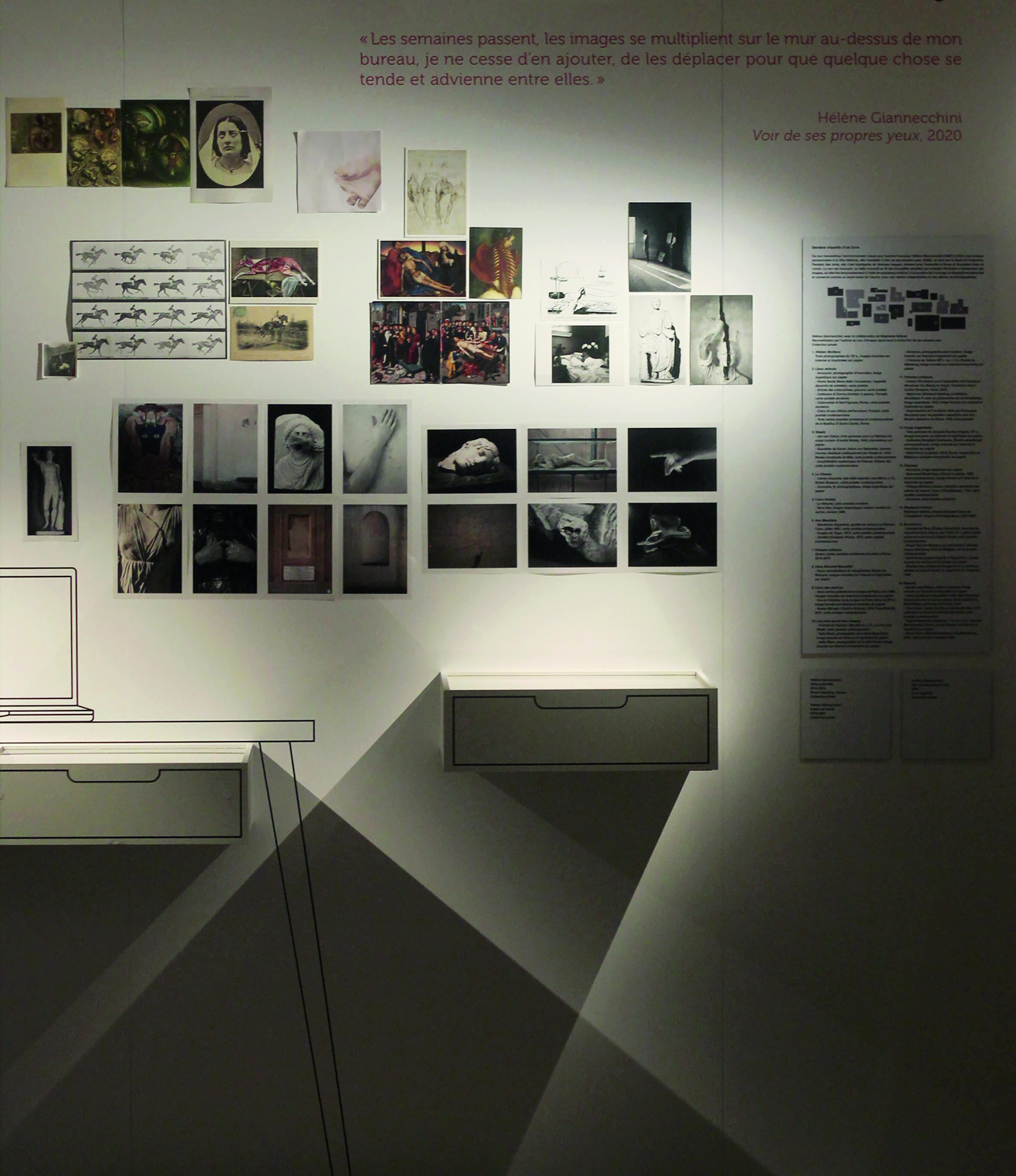
1In her second novel, The Flamethrowers (2014Kushner, Rachel. The Flamethrowers, Vintage Books, 2014.), American writer Rachel Kushner presents a vibrant fresco seen through the eyes of a young woman
nicknamed Reno, who arrives in New York with the desire to transform her fascination with motorcycles and speed into art. From New York to Italy, from the First World War to the 1970s, multiple narratives and locations
intertwine, giving rise to a dynamic explosion of images and artistic
gestures. The writing of the novel itself was inspired by images
(artworks, stills from films, photographs, and more). Kushner’s image-acting revolves around “pinning up”, collecting and capturing images while writing The Flamethrowers A Portfolio: Rachel Kushner and The Flamethrowers (2014) . She refers to this collection of images as
“a large stash” (2021, p. 119Kushner, Rachel. “Made to burn,” dans The Hard Crowd: Essays (2000-2020), Scribner, 2021, p. 113–136.), secret reserves of images, new
forms of hidden drugs. While some parts of this stash are revealed, particularly through the
concrete presence of images in Kushner’s writing, other fragments remain thinly
scattered throughout the writer’s interviews and essays.
. She refers to this collection of images as
“a large stash” (2021, p. 119Kushner, Rachel. “Made to burn,” dans The Hard Crowd: Essays (2000-2020), Scribner, 2021, p. 113–136.), secret reserves of images, new
forms of hidden drugs. While some parts of this stash are revealed, particularly through the
concrete presence of images in Kushner’s writing, other fragments remain thinly
scattered throughout the writer’s interviews and essays.
2These traces of images can be felt and seen in the narrative of The Flamethrowers: motorcycles, art, power, sound, energy, and moments of “suspension” (Kingston-Reese, 2019, p. 134Kingston-Reese, Alexandra. Contemporary Novelists and the Aesthetics of Twenty-First Century American Life, University of Iowa Press, 2019.) serve as inspirational and imaginative forces. Briac’s original illustration captures and interprets the fleetingly mentioned images that inspired Kushner’s writing. In this sense, images can act as a force of deliberate misremembering, or dismembering, thus transforming both written and visual images into perplexing, meaningful, and potentially revelatory artefacts within the novelistic construct.
“I Told It My Way”: Re-membering and Mis-remembering
3Images exert a strong, mysterious pull on the writer, and this compulsive, meaningful force seems to be the starting point of Kushner’s writing:
I’m drawn to images and seem to start with them. Or one. Something I imagine, a scene or detail, or even a photograph, something that has a charge of meaning that can’t be easily reduced (The Open Bar, 2016The Open Bar. “A Psychotic Pattern of No-Pattern: A Conversation Between Rachel Kushner and Dana Spiotta,” Tin House, September 2016. https://tinhouse.com/a-psychotic-pattern-of-no-pattern-a-conversation-between-rachel-kushner-and-dana-spiotta.).
4Images that cannot be easily reduced can also be reinterpreted, with their material form diverging from the writer’s imagined perception of the picture and its depiction within the narrative frame.
5In The Flamethrowers, Reno ruminates in considerable detail on a photograph in Time magazine of a woman struck by a meteorite. In an interview, Kushner recalls the first time she saw that photograph which later took another form in her novel:
I’d seen a photograph of a woman who was hit by a meteorite when I was little and I never forgot it. The book allowed me to correctly and precisely misremember it in just the way I had as a child. Way after I wrote the scene, just before my book was published, I went online and found the real photo. It was a grainy black and white image of a traumatized and half-destroyed-looking person in a barren hospital room, not at all like what I’d conjured—a proud woman in a cheerful kitchen. But that’s fine. I told it my way and what’s wrong is right because it is about the unconscious (Lee, 2014Lee, Jonathan. “Rachel Kushner: The Useless Truth,” Guernica, February 2014. https://www.guernicamag.com/the-useless-truth/.).
6Thus, several versions of the same event can coexist, and while images such as this photograph may not be forgotten, they can be misremembered, distorted, or reinterpreted through time and space.
Stilled Images
7In The Flamethrowers, Reno is invited to Italy by the Valera racing team for a grand tour, which is supposed to be filmed. Before leaving for Europe, Reno reflects:
I had an idea for the film, of filming up close, in dilated view, the poster of Flip Farmer. Going close to his face, scanning his body, the flameproof suit, his arm over the helmet. A meditation on that stilled image, the monstrously white, pure smile. And then intermixing myself. The Valera team. My own driving gloves. My helmet (2014, p. 209Kushner, Rachel. The Flamethrowers, Vintage Books, 2014.).
8As the narrator of her novel, Kushner is keenly interested in meditating on stilled images. The vision of the fictional American racer Flip Farmer, whom Reno admires, evokes Craig Breedlove, a real American racer—Kushner used to pick up postcards of Breedlove and his vehicle, The Spirit of America, in gas stations (Bollen, 2013Bollen, Christopher. “Rachel Kushner’s Reno, L.A., and New York,” Interview Magazine, May 2013. https://www.interviewmagazine.com/culture/rachel-kushner-the-flamethrowers.). Breedlove was notably photographed in front of his car, in his racing suit, with an arm over his helmet. In the novel, Reno drives The Spirit of Italy, and the first chapter of her narrative is entitled “Spiritual America”. Kushner was also inspired by Lee Breedlove, Craig Breedlove’s wife, who drove her husband’s vehicle and who became the fastest woman alive. Kushner recalls:
[T]here’s a photo of her posing next to the Spirit of America and she is this busty, gorgeous woman with cat-eye makeup. [.…] She’s next to the back of the vehicle, which has this huge, open jet exhaust that looks like a Lee Bontecou sculpture. I thought about the ’60s and NASA and speed and women; somehow it all came together for me with that image (Owens, 2013Owens, Laura. “‘It’s spelled Motherfuckers.’—An Interview with Rachel Kushner,” Believer Magazine, May 2013. https://www.thebeliever.net/logger/2013-05-24-its-spelled-motherfuckersan-interview-with/.).
9These photographs evoke Reno’s filming ideas and her own racing experience as the first-person narrator manages, improbably, to become “the fastest woman in the world” (Kushner, 2014, p. 135Kushner, Rachel. The Flamethrowers, Vintage Books, 2014.). Thus, the novel operates on the idea of “stilling” images to reflect on intermixed experiences.
Capturing Traces
10If Reno views the motorcycle as a means to capture her art, The Flamethrowers opens in 1917 with the character of T.P. Valera
striking a German soldier with his motorcycle headlamp. The image of the
motorcycle serves as the starting point of the novel, reflecting on the
effects of speed, technology and futurism, but it is also the genesis of
the novel’s writing. During the process of writing The Flamethrowers, Kushner places several images on her wall Un mur d’images comme genèse visuelle d’un livre , one of which depicted a
motorcycle:
, one of which depicted a
motorcycle:
One of the first images that I put up was of a soldier from World War I riding a motorcycle with a really crazy sidecar contraption on it that was shaped like a bullet. There was another guy in the sidecar who looked like he was kind of his amanuensis. He had a typing machine and was taking notes. That sounds kind of precious! I found the picture online and just put it up in my office (Electric Literature, 2016Electric Literature. “Rachel Kushner, Rivka Galchen & Hari Kunzru in Conversation, from Upstairs at the Strand,” Electric Literature, March 2016. https://electricliterature.com/rachel-kushner-rivka-galchen-hari-kunzru-in-conversation-from-upstairs-at-the-strand.).
11The figure of the “amanuensis”, sitting and taking notes while moving along, evokes the role of the writer, transcribing the words of another. The motorcycle and its sidecar contraption become the means of capturing “precious” moments that inspire creation, both textual and visual creation.
12Thus, Rachel Kushner intermingles external images and vivid memories, mental forms of images, that are transformed within the imaginative writing process. Material images contribute to bringing life to Kushner’s protagonist and inspire Reno’s experiences within The Flamethrowers. Reno’s project of capturing the traces of her motorcycle finds its roots in a photograph of motorcycle tracks:
I had seen a photograph of huge arcing motorcycle tracks Michael Heizer had made at El Mirage Dry Lake in California. I thought, what if it’s my character who made these? (Owens, 2013Owens, Laura. “‘It’s spelled Motherfuckers.’—An Interview with Rachel Kushner,” Believer Magazine, May 2013. https://www.thebeliever.net/logger/2013-05-24-its-spelled-motherfuckersan-interview-with/.).
13The motorcycle’s traces become visible, eternalising the experience of speed, but Reno’s tracks deviate from an arcing pattern as the narrator was the victim of a crash:
What seemed like endless perfect white on white was only a very thin crust of salt. Where the crust had been broken by the force of impact, mud seeped up. I photographed all this, a Rorschach of my crash (2014, p. 114Kushner, Rachel. The Flamethrowers, Vintage Books, 2014.).
14The images-traces in The Flamethrowers appear as their own projective test, disrupting any fixed pattern: Kushner’s image-acting thus seems to rely on traces of traces, subliminal experiences, fleeting yet permanent forms of pictorial imagination.
References
- Bollen, Christopher. “Rachel Kushner’s Reno, L.A., and New York,” Interview Magazine, May 2013. https://www.interviewmagazine.com/culture/rachel-kushner-the-flamethrowers.
- Electric Literature. “Rachel Kushner, Rivka Galchen & Hari Kunzru in Conversation, from Upstairs at the Strand,” Electric Literature, March 2016. https://electricliterature.com/rachel-kushner-rivka-galchen-hari-kunzru-in-conversation-from-upstairs-at-the-strand.
- Kingston-Reese, Alexandra. Contemporary Novelists and the Aesthetics of Twenty-First Century American Life, University of Iowa Press, 2019.
- Kushner, Rachel. “Made to burn,” dans The Hard Crowd: Essays (2000-2020), Scribner, 2021, p. 113–136.
- Kushner, Rachel. The Flamethrowers, Vintage Books, 2014.
- Lee, Jonathan. “Rachel Kushner: The Useless Truth,” Guernica, February 2014. https://www.guernicamag.com/the-useless-truth/.
- Owens, Laura. “‘It’s spelled Motherfuckers.’—An Interview with Rachel Kushner,” Believer Magazine, May 2013. https://www.thebeliever.net/logger/2013-05-24-its-spelled-motherfuckersan-interview-with/.
- The Open Bar. “A Psychotic Pattern of No-Pattern: A Conversation Between Rachel Kushner and Dana Spiotta,” Tin House, September 2016. https://tinhouse.com/a-psychotic-pattern-of-no-pattern-a-conversation-between-rachel-kushner-and-dana-spiotta.
- Worthy, Blythe. “The Problem with Identity Politics: Dialogical Interrelation in Rachel Kushner’s The Flamethrowers,” Philament: An Online Journal of Literature, Arts and Culture, vol. 22, 2016, p. 57–86.